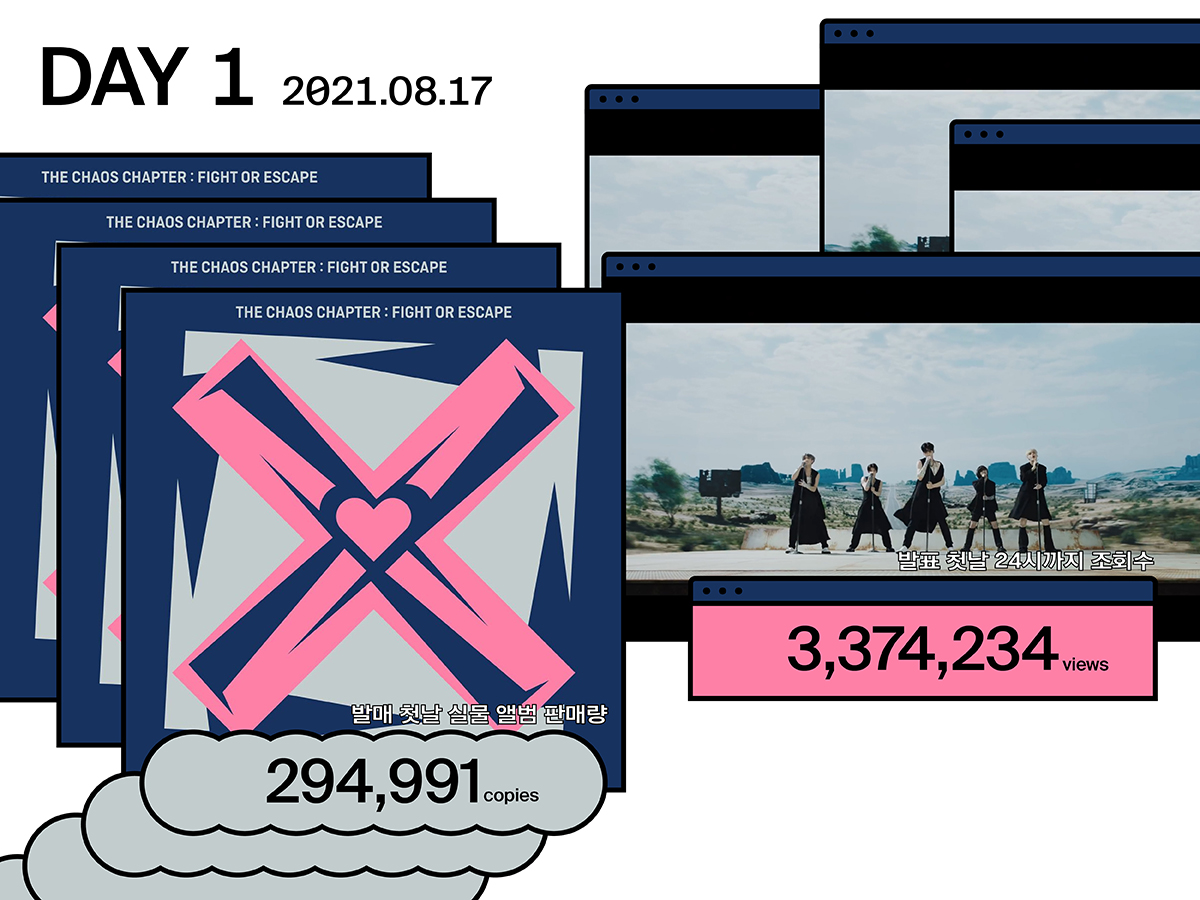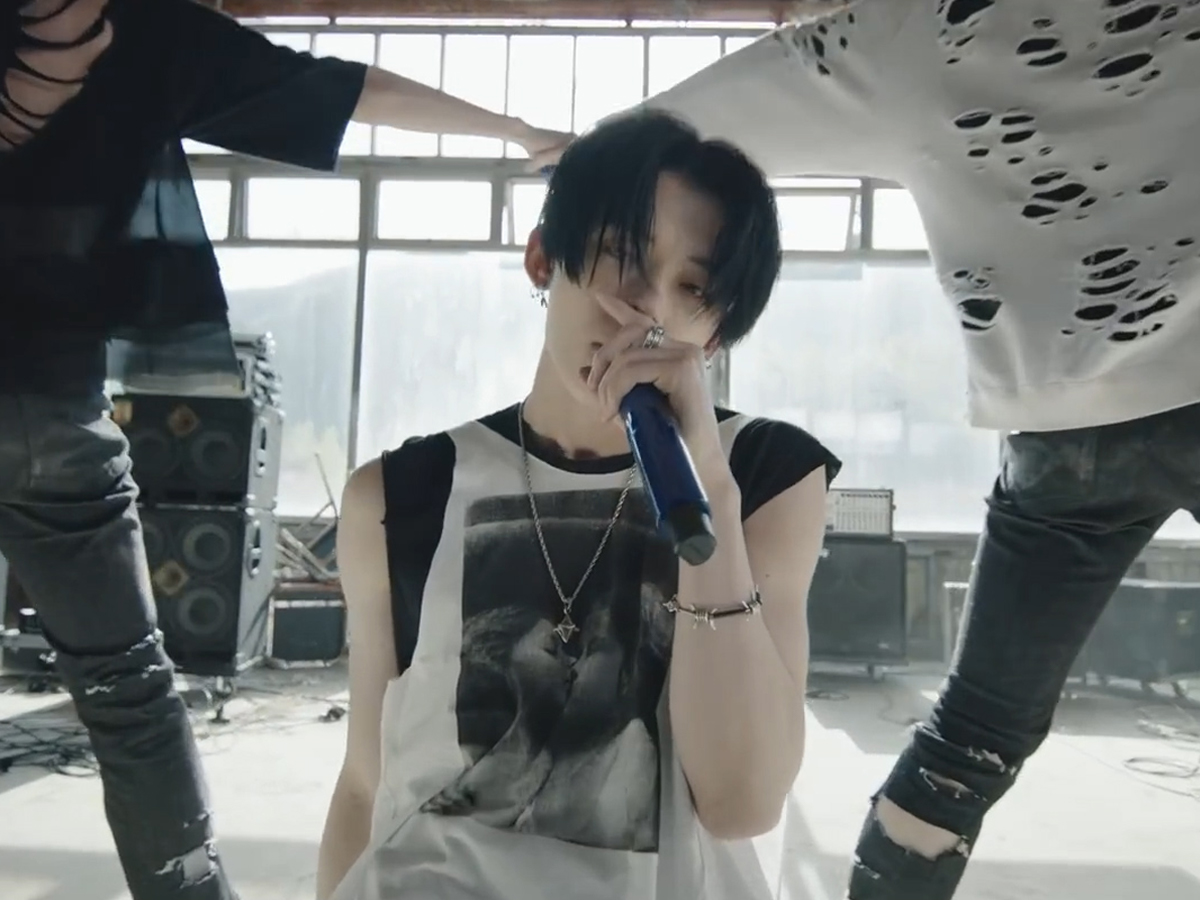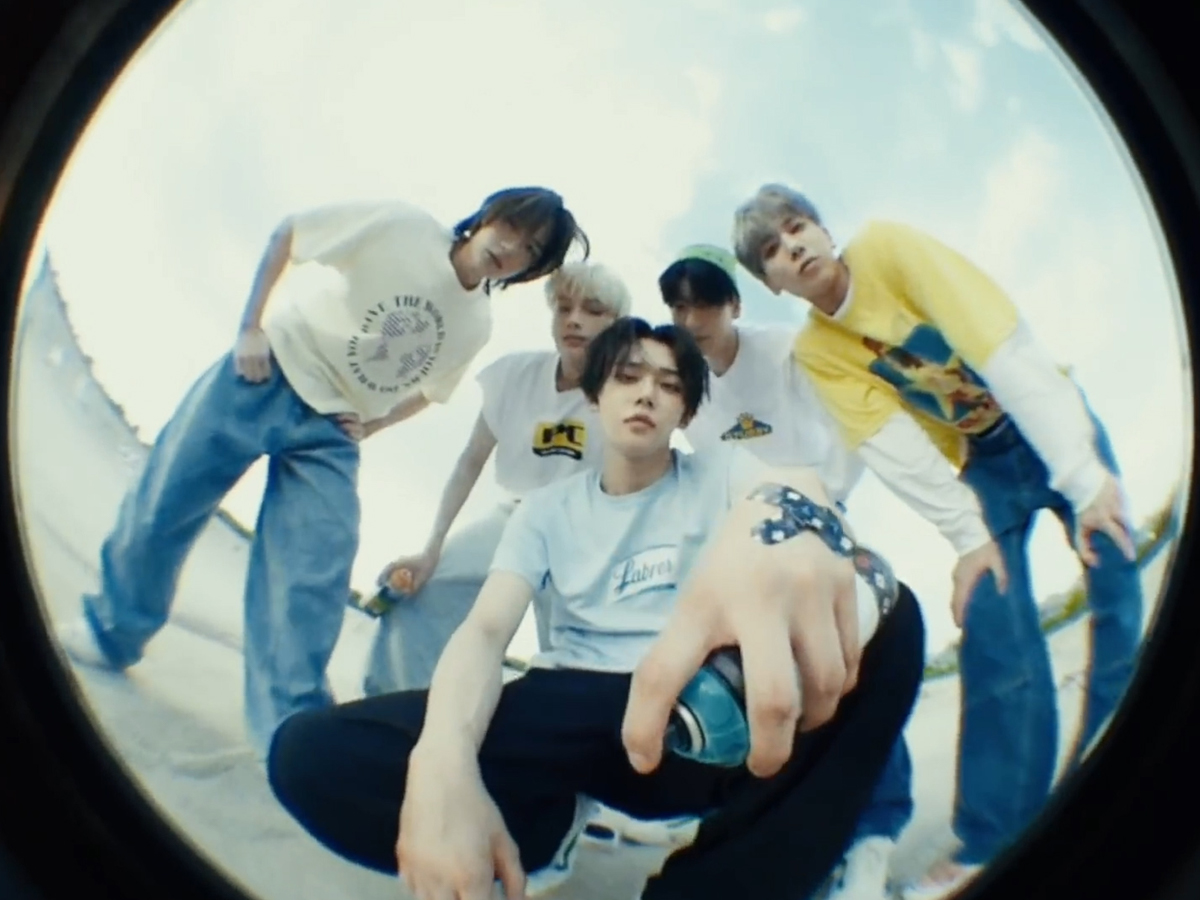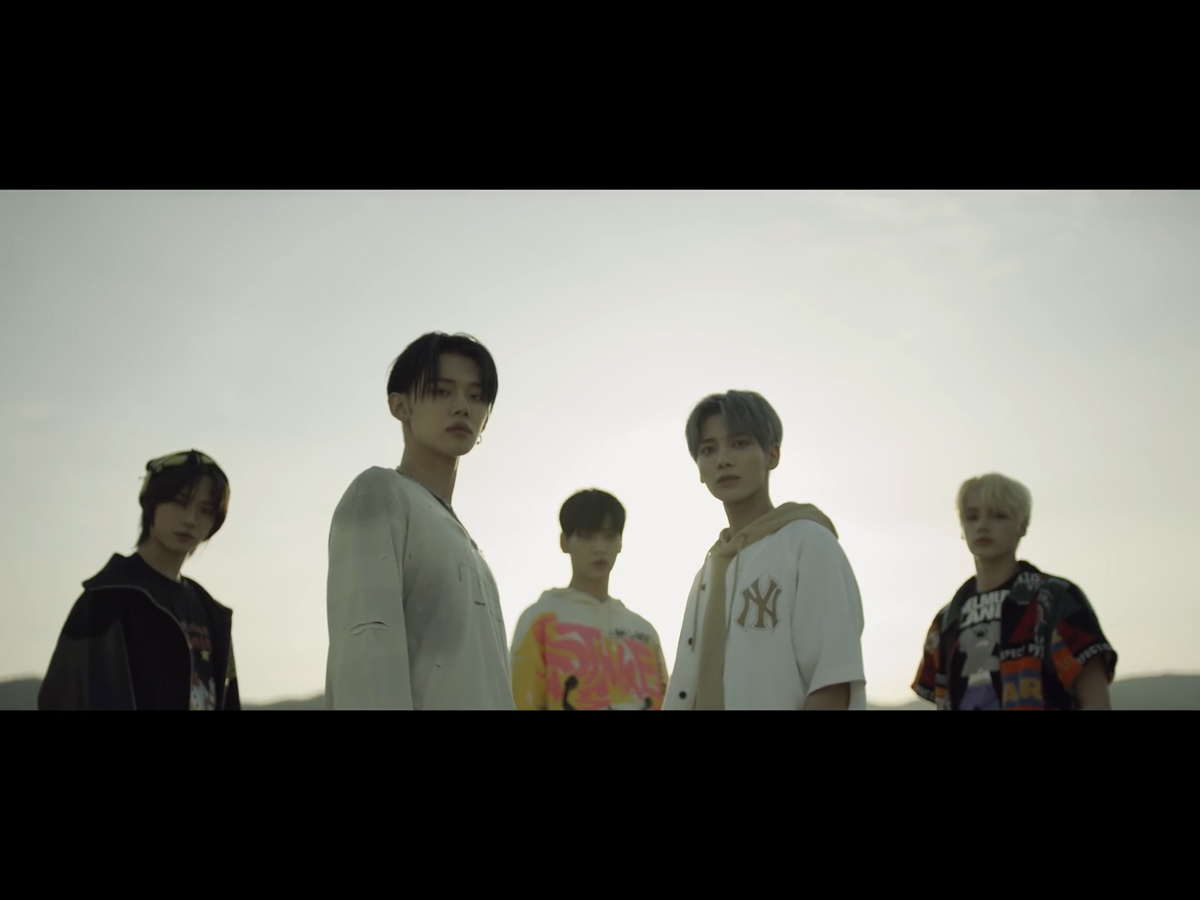
The writing’s on the invisible wall
Myungseok Kang: In the music video for their song “0X1=LOVESONG (I Know I Love You)” featuring Seori, the lead single off their album The Chaos Chapter: FREEZE, the members of TOMORROW X TOGETHER steal YEONJUN’s parents’ car and run away from home. But for “LO$ER=LO♡ER,” the lead single off the repackaged album, they sing of “fleeing in a silver car.” Like in the “ESCAPE” concept clip released before the repackage, they may have even become “WANTED” since their escape in the car. And so, as the lyrics to “LO$ER=LO♡ER” say, they “run” away with “hunnit bands” in hand. As the new song implies with the line, “you’re my salvation,” the boys’ story of waiting for someone to come save them, as when they sang about “the on1y rule” in “this world of zero” in “LOVESONG,” is now something of the past. On the run, in need of money, and being pursued, they confess to being “exhausted now.”
“I’m a LO$ER I’m a LO$ER / Lover with a dollar sign”: Here, TOMORROW X TOGETHER realizes that their escape is a form of “unwinnable fighting”; as that escape drags on, the very money that symbolizes reality paradoxically becomes more of a necessity. Be you a loser or a lover, there’s always a dollar sign branded onto the mind. Knowing this is what leads them to declare themselves “LO$ERs.” Through the rising melody in the chorus, “LOVESONG” expressed the energy they felt in the moment when, butting up violently against reality, they dreamed of salvation. The descending melody of the “LO$ER=LO♡ER” chorus has the boys accepting themselves as “LO$ERs,” realizing they cannot escape from “a $ dollar sign” no matter how they try. Whether they choose to run or to fight, their “shaky flight” doesn’t end easily; either way, a life of “fighting” and “losing” is exhausting. But there’s no escaping it. The world is not about to tolerate the unknown territory of fantasy. The world pushes people to learn about money before they reach their teens, and once they do, they inevitably discover that, paradoxically, they require more money in order to “ESCAPE” from the world.
Here we witness the intersection of Generation Z—those around the world now in their teens and 20s—and the fourth generation idols, the latest cohort in one system of classifying different generations of Korean idols. The way “LO$ER=LO♡ER” combines metal with rap built on trap beats and pursues this as a style rather than one preconceived genre is familiar territory for Gen Z. Performance-wise, as well, the combination of group choreography with microphones on stands is possible thanks to the backlog of Korean idol group performances, which handily mix and match performances of all genres in their choreography. TOMORROW X TOGETHER plays with the many formats that brought success to previous generations but without concern for their original genres. Despite this, whether it be music or something else, it’s difficult to make something completely new—something they can wholly call their own. What’s become important is to combine everything into something that sounds cool—the so-called Gen Z sense: a vague feeling and style among other artists of the generation, one we feel whenever we experience the likes of Billie Eilish, Olivia Rodrigo or the Kid LAROI—that sense that you know when you hear it. As fourth-generation idols of Korean music, TOMORROW X TOGETHER also have something to contribute to this generation based on what they inherited from the previous one. Fourth-gen idols like them stepped into the existing idol world that was by then an oversaturated market. This is what they mean when they say “unwinnable fighting,” and where they declare themselves “LO$ERs” who await an end to their “shaky flight.” And yet, nevertheless, just as YEONJUN raps at length toward the end of the song, they work toward a place where they can convey their feelings with finesse. It’s a way for a generation unlikely to be able to be a part of rebellion, resistance or revolution to leave their own mark on the memory of the world. Perhaps this is their way of fighting—living life with an attitude that says, “Even if they all mock me, I don’t care,” and reaching their hand out to someone like themselves, singing, “We should have hugged each other anyway.”
The music of fourth generation idols in 2021
Randy Suh (Music Writer): TOMORROW X TOGETHER’s The Chaos Chapter: FREEZE was one of the most intriguing albums of the first half of the year. There have been a lot of claims over which K-pop idols belong to the fourth generation, but it’s been hard up until now to point to some musical trait and say, “this is the 4th gen.” Maybe it’s because the third and fourth generations find themselves coexisting at the moment in the K-pop scene. Even though we still can’t say for sure what that breakthrough for the fourth generation will be, it seems TOMORROW X TOGETHER at least have found a clue in the form of the emo rock and pop punk style K-pop found in their albums The Chaos Chapter: FREEZE and The Chaos Chapter: FIGHT OR ESCAPE.
Emo rock and K-pop idols might not seem to have anything to do with one another, but if we look at the American pop scene, it was emo rock bands who became the stopgap male pop groups between the Backstreet Boys and NSYNC era and the time of Justin Bieber and One Direction. Teenagers who weren’t satisfied with mainstream culture loved bands like My Chemical Romance and Panic! at the Disco the way they do idols today. Even while trends have shifted to other subcultures like anime and K-pop, the emo and grunge spirit lives on in non-mainstream TV shows and egirl fashion and is witnessing a showy revival in 2021. This is a time when the Kid LAROI’s album can top the Billboard 200 even though it’s already been about a year since its release; TOMORROW X TOGETHER saw this as a signal and reacted quickly and shrewdly. Considering when they were working on the album, they can be considered to have developed around the same time.
“LO$ER=LO♡ER” follows in the emo rock steps of “0X1=LOVESONG (I Know I Love You),” featuring Seori. The big difference between the two is that the strength of the nostalgia for the early 2010s is stronger on the latest track. Both “Price Tag,” the Jessie J song that was massively popular at the time of its release in 2011, and “Lonely” by 2NE1 have a similar chord progression to TOMORROW X TOGETHER’s song. Unlike the songs that came before it and their I-iii-vi-IV chord progression, however, there’s an unusual nuance to “LO$ER=LO♡ER” owing to its three-chord progression, I-iii-vi, making it difficult to pin down whether it’s major or minor. Of course, this chord progression isn’t exclusive to the 2010s, but considering how many K-pop songs use elaborate, contemporary R&B-derived chords lately, the unsophisticated simplicity of “LO$ER” is more pronounced. It’s more melancholy than Disney idol pop punk, but lighter and more polished than emo rock proper. Maybe we can find the new sound of the fourth generation somewhere on this spectrum.
Our world is made from a unknown language
Hyunkyung Lim: In The Chaos Chapter: FIGHT OR ESCAPE, TOMORROW X TOGETHER replace the familiar letter S with a dollar sign in a song titled “LO$ER=LO♡ER” to present us with an unfamiliar phrase. Faced with choosing an identity between two halves—winner or loser, “believer or saver”—the boys instead create new terms for themselves outside of the binary without adhering to one side or the other (“What if I had been that PUMA”). “LOVE” is “LO$E,” implying a level of squandering that necessitates huge expenses (“hunnit bands,” or money wrappers), while “eternity” (which, in Korean, mirrors the pronunciation of young, or “zero,” and “one”) is “0X1”: emptiness, absence and the desire to be “together.” The boys arrive at The Chaos Chapter and describe their situation as “our own code” (“MOA Diary (Dubaddu Wari Wari)”) where previously they had alluded to the existing world and borrowed words from universally known fantasy works in order to talk about themselves, as with simple vocabulary like “horn” in “CROWN,” which stood for unfamiliar feelings of loneliness, or platform “9 and Three Quarters (Run Away),” which is a direct reference to the popular Harry Potter fantasy novel series.
The language of TOMORROW X TOGETHER, which changes obvious words into something less obvious, points to the void in place of the reality we always assumed to be there. In the “ESCAPE” concept clip, the members rob a store packed with goods on display. This deviance is defined as delinquent stealing by society, but for the boys, it’s their way of stealing away from, or escaping, the adult world. This is an image of the inner life young people live, hidden from view by phrases like “growth and development” or “working hard for a bright future.” In that sense, TOMORROW X TOGETHER’s Chaos isn’t merely the usual wanderings of youth; rather, it suggests a time of conflict—one that occurs when the established grammar and vocabulary for defining oneself fail to capture their true identities.
“Anti-Romantic,” a track off The Chaos Chapter: FREEZE, saw immense popularity on TikTok, a social media platform dominated by users in their teens and 20s. The song defines the group as “Anti-Romantics,” caught between the desire to be “Lovers” while hesitating as they think of the “red line” on the bill. Moreover, theirs is a language that has become one that demonstrates the trends associated with others of their generation as seen on social media such as TikTok. TOMORROW X TOGETHER gave “our own code” not only to themselves but to “you and me”: everyone in their generation who listens to the music. The “code” is spread through social media and provides a language for “us,” the people who can join together as one. This is also a question about the world: Is it right for the world to exist without this language they’ve given “us”?
Unauthorized reproduction and distribution prohibited.
- TXT is advocating Gen Z’s music2021.06.16

- TOMORROW X TOGETHER: the star retrievers2021.08.09

